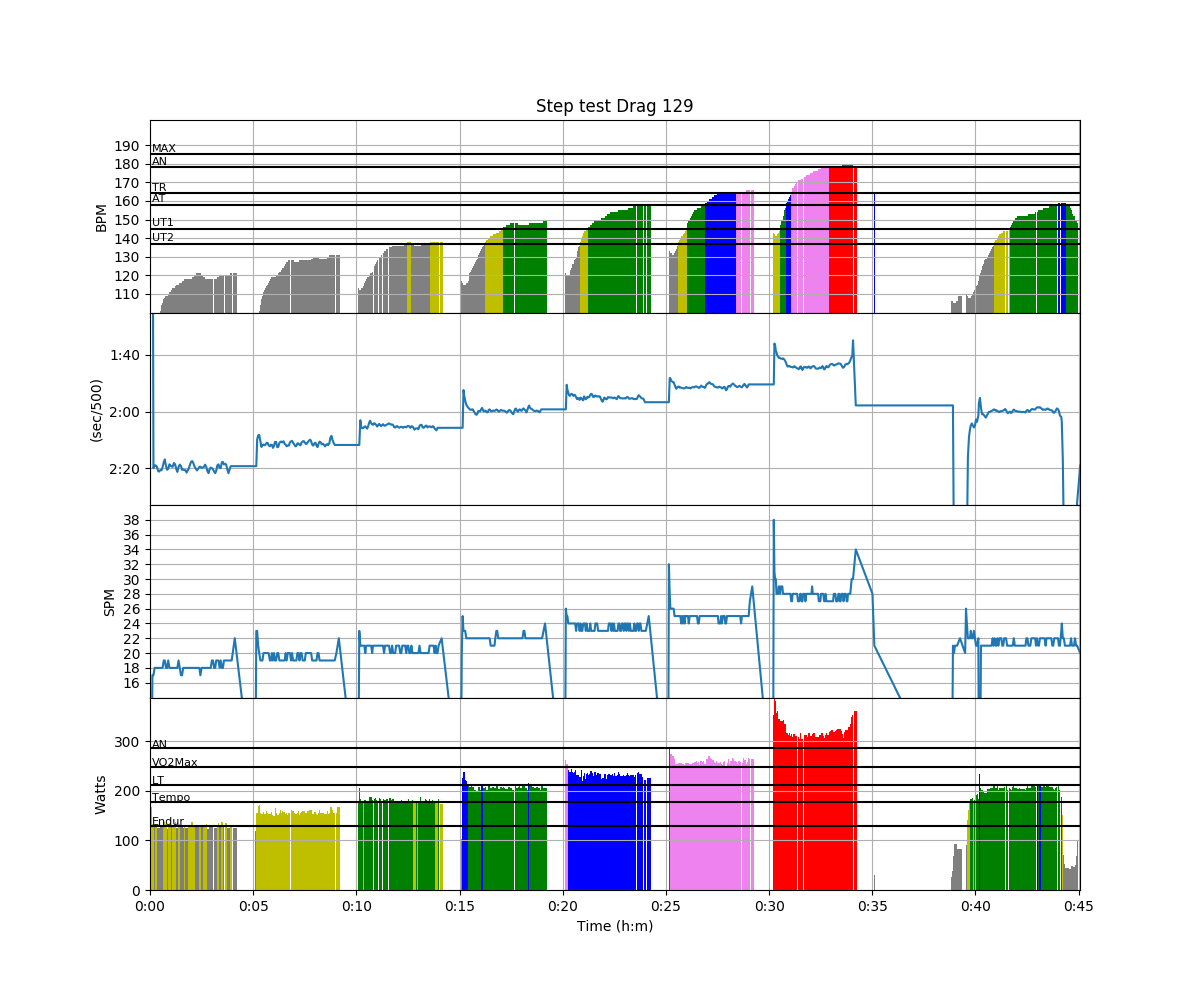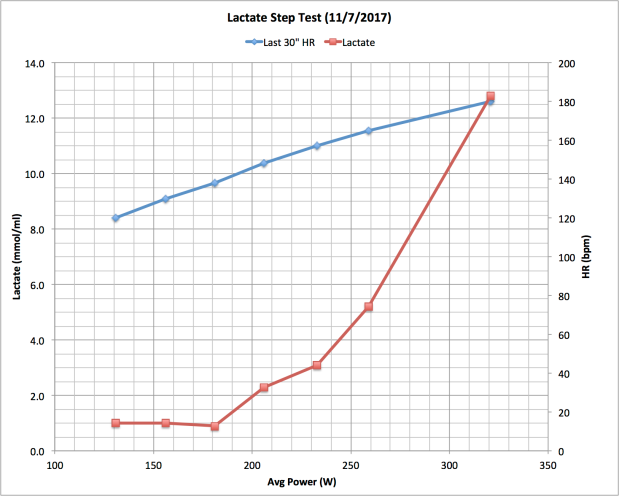Using the AIS Step Test Protocol
I estimated that my current 2k time would be around 7:00, or a 1:45 pace. The protocol provides the following step powers

Getting myself setup was a bit complicated.
- HR sensor, connected to PM5
- PM5 connected to painsled
- headphones on, connected to iphone
- Spotify set to my “8×500” playlist
- Drag set to 130
- Seat pad on erg
- wet towel
- dry towel
- lancet tool
- lactate meter battery OK
- lay out 10 lactate test strips neatly
- fan on
- PM set to 4 minute intervals/1 minute rests, display to power
Then I did a baseline lactate test, just to make sure that I remembered the process.
- wipe hands with dry towel
- wipe sample finger with wet towel
- dry sample finger
- lance fingertip
- pick up meter with non-sample hand
- pick up strip with sample hand and insert strip
- make sure meter has woken up
- visually judge size of droplet
- If it is too small, put hand down low for 5 seconds
- dab droplet with strip, starts 13 sec count down on meter
- wipe finger
- get a drink
- get feet set for next interval
- write down reading
When executed well, this whole process takes about 45 seconds. If there are any hiccups, it takes the whole 1 minute rest time.
The baseline was 1.4mmol/ml which is a perfectly reasonable reading.
Then I did the test. The steps start ridiculously easy. The key thing in my mind is to try to hit the power exactly on every stroke. I ended up bouncing a few watts up and down, but staying focused on the target kept me occupied while it was easy.
The target for the last step is “max”. I changed the display from watts to pace per 500. I wasn’t quite sure how hard I could hold for 4 minutes. I decided to try to make sure I did it faster than 1:45. As it turned out, I was able to accelerate in the last minute, so I probably could have pushed it a bit harder, but my HR was above 180 at the end so I was working pretty hard.



OK, so I did the test. What’s the point?
The main reason to do the test was to have a baseline to compare after training blocks are completed.
Beyond that, the curve can be used to estimate my current Lactate Threshold. There are multiple ways to extract this from the curve. The simplest is the power at which the lactate level exceeds 4.0mmol/ml. This gives an estimate of 243W (1:52.9). A more conservative method is to draw a best fit line for the sub-2.0mmol points and another for the steep part of the curve, and the point where they meet is the LT.

This method yields about 238. So, about 240 is a good guess. How does this compare with the 20′ test? The test measured 244W. So there!
The other useful output is a first cut at appropriate steady state training power. The goal here is to train at the highest power that results in a steady state lactate level at or below 2.0mmol/ml. From this test, training power should be between 180 and 205W.
Other testing I have done in the past shows that lactate tends to drift up slowly over a long steady state session, so something towards the bottom of this probably more appropriate.



I am going to do one on Saturday, according to a protocol prescribed by our head coach but with lovely assistants to take blood from my ear. The only thing I have to do is Row.
LikeLiked by 1 person
It would be a lot easier with an assistant, but I don’t think my wife would be willing to be conscripted for it. It would test the bounds of trust in our marriage!
LikeLiked by 1 person
Just an observation. The Australian test gives some recommended drag factors. The two to be aware of are for Junior/Lightweight and Heavyweight men. Having had this test done to me in my youth the recommended drag factors were J/LW 125 and senior heavyweight 130. To get a female HWT invite you have to go under 7 for a 2k and that drag factor is 110. You might want to ease off your load next time. That will favor the aerobic work over anaerobic from a higher drag factor.
I just started experimenting with a modified Conconi test. The 7×4 is based on the original Conconi test and was designed to have long steps to allow for lactate stabilization. The modified Conconi looks for LT2/FTP thresholds. 10 min warm up then 15 min with 30′ 5 watt steps starting from the same level as the AIS protocol. The rub against it was always looking for the heart rate deflection. Those studies were done before the PM3 so there were fewer data points on the HR and power collection. Easier to do now with a PM% and painsled and repeat in a month.
The AIS has been trying to create some other protocols you may find useful. http://www.rowingaustralia.com.au/wp-content/uploads/2015/02/2013-2016-National-Rowing-Ergometer-Protocols-V3.0.pdf – the 6x6min every 2 weeks seems a good progress check.
LikeLiked by 1 person